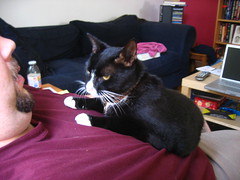I started to write this post a few weeks ago, but I haven’t been able to pull the trigger. Guinness is a 2 year old black and white cat, found as a kitten on a doorstep in Shaw by friends of ours at about six weeks old. We took him at our friend’s behest and he’s been our able companion for the last two years or so…until he went missing the day after our wedding. Now, Guinness is an indoor/outdoor cat, so I am used to absences up to 24 hours (he’ll spend the night out hunting during the spring and fall), but beyond that I get a bit twitchy.
We papered the neighborhood with flyers. We called the nearby animal shelters and vets. We walked the neighborhood calling for him. We did everything just short of crawling through all the nearby brambles and knocking on every door in all of Fairlington. It was torture to just not know what happened to our Guinness. Just awful. But through all this, we got calls from the shelters saying they hadn’t seen him and wanted to know if he’d come home yet. No sign. Nothing.
Until Saturday. When I got a call from our neighbor to say he was spotted on our front porch. Tiff and I were on the last leg of our roadtrip across the midwest and after crashing the night in Pittsburgh, we sprinted home to greet our missing kitty. We’ve been through the worst, it looks like. The vet checked him out this morning and despite some issues with a foot with a cut, he’ll be just fine in about a week.
I was prepared to post this in the case that we gave up on Guinness, that we were ready to mourn him and suggest ways to do it. I am glad, now, to turn this into a post on who to talk to if you lose your pet in DC. Read on for all the details.
This post appeared in its original form at DC Metblogs
Losing your pet absolutely, positively sucks. This guide is here to help DC area residents cope with the loss of their pet, how to actively get out the information about your missing friend, and who to call.
First things first, make a flyer. We made ours with Pages, cheap software for the Mac, and flyers can be made easily with Word or pretty much any major word processing application. The pertinent information you will want to put on there: Where your pet was last seen. When your pet was last seen (time and date). Name of the pet. Description or, if possible, picture of the pet. Tear strips that include your contact information. Phone is better than Email, but both will work. Reward, if offered.
Secondly, post the flyer in your neighborhood. If you live in a building, post it by the mailboxes, or in another high traffic area. If you live in a neighborhood, use the bus shelters and light standards to post your flyer. Do NOT post over other peoples’ flyers. Do use an easy-to-remove tape like Scotch Invisible. It’s fairly strong, but best of all, doesn’t leave a messy residue or cause damage. Take a copy of the flyer to each of your neighbors and leave it with them so they can be on the lookout if your pet comes home before you do.
Third, call the animal welfare league or shelter. These are the folks who strays come to, either by animal control, or by being brought in. They are your best friends in all the world. In DC, it’s the Washington DC Humane Society or the Washington Animal Rescue League. In Montgomery County, it’s the Animal Welfare League of Montgomery County or the Montgomery County SPCA. Prince George’s County has a full list of helpful organizations. In Arlington, talk with the Animal Welfare League of Arlington, and in Alexandria, talk with Animal Welfare League of Alexandria. Check the hours on their website, then call when they’re taking reports. Give them your pets name, a full description (including breed if applicable) and your full contact information. If they get a report about your pet, they’ll call you to retrieve your pet.
Fourth, call area veterinary hospitals. Vet Hospitals will sometimes take in strays as well, and you can use Google Local to find veterinarians and pet hospitals near your home. Call them all and report a missing pet, that way, you’re covered in case they show up there.
Fifth, walk your neighborhood calling for your pet. Sometimes, this will be enough to bring your pet out of their hiding place, or back from the wild. Good times for this are right around dusk, when most pets are their most active.
Other suggestions would be to talk with local dogwalkers as they see a lot of the neighborhood that you might perhaps miss, talk with your neighbors, besides, it’s been too long since you saw them anyway, and most important: don’t ever give up.
This post appeared in its original form at DC Metblogs



